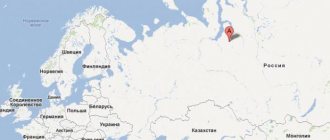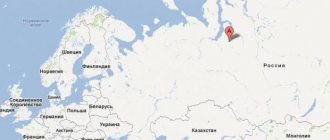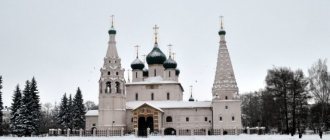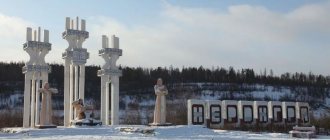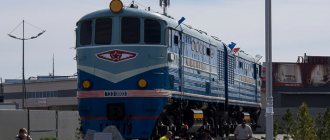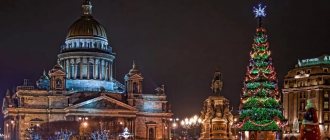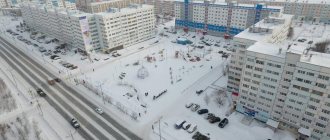| Coat of arms of the urban settlement of Pushkino | |
| Details | |
| Approved | June 24, 2010[1][2] |
Coat of arms of the urban settlement of Pushkino
- is the official symbol of the urban settlement of Pushkino, Pushkin municipal district, Moscow region.
The coat of arms and the regulations on the coat of arms were approved on June 24, 2010 by the Decision of the Council of Deputies of the urban settlement of Pushkino, Pushkin municipal district, Moscow region, dated June 24, 2010 No. 94/10/2 “On the coat of arms of the urban settlement of Pushkino, Pushkin municipal district, Moscow region”[1][2 ].
First coat of arms
The first coat of arms of the city was approved by the executive committee of the city Council of Workers' Deputies on June 10, 1975.
The main element of the coat of arms is the emblem of the unbreakable alliance of the working class and the peasantry - “The Hammer and Sickle”. The basis of the coat of arms is a heraldic shield, divided vertically into two stripes: blue and green. The combination of the red color of the “Hammer and Sickle” emblem and blue means that the city belongs to the Russian Federation, and the green stripe is a symbol of the green zone of the Moscow region and developed agricultural production. In the center of the coat of arms there is heraldic symbolism: the sable is the personification of fur production, the reels of the bobbins reflect another specificity - spinning and weaving, part of the gear symbolizes other types of industry.
Author of the coat of arms
: V.I. Andrushkevich.
Second coat of arms
The city's second coat of arms is almost exactly the same as the 1975 design, but the Hammer and Sickle emblem on the red field has been removed. This version of the coat of arms was approved by decision of the Council of Deputies of the Pushkin District No. 294/34 of January 25, 2002.
Heraldic description of the coat of arms:
| In a field dissected by azure (blue, light blue) and green, there is a narrow black ring, jagged on the outside, bordered with gold and filled with purple; inside the ring is a wrapped, seated golden sable, and on either side of it on top of the ring are two golden spools of thread. [3] |
The coat of arms is included in the State Heraldic Register under No. 934.
Author group
: Vladimir Andrushkevich, K. Mochenov (revision), Galina Tunik (justification), Yuri Korzhik (computer processing).
After the municipal reform, this coat of arms was retained by the Pushkin district. A different coat of arms was developed for the urban settlement “city of Pushkino”.
Coat of arms of the city of Pushkino 2008
Description:
In a scarlet field with a right azure wavy edge bordered inside with gold and with a left emerald wavy edge bordered inside with gold, accompanied at the top by a gold Ionic column with a rafter-shaped cutout in the form of an open curtain, and below by a silver wheel inside of which there are five silver reuts (bells) .
In the free part there is the coat of arms of the Moscow region. The coat of arms is surmounted by a golden city crown .
Rationale for symbolism:
The basis of the coat of arms is the French heraldic shield, the shape of which is traditional for many cities in Russia and the Moscow region. The coat of arms is surmounted by the crown of the municipality. On the Pushkin land there are burial mounds of the 10th-12th centuries, (preserved), they are reflected in the coat of arms in the form of green hills. The same color reflects the location of the city in the green zone of the Moscow region. The village of Pushkino (known since 1499) is now part of the territory of the city of Pushkino. Two roads pass through the city of Pushkino (Troitsky tract) now Yaroslavskoye Highway, and a railway (Trans-Siberian Railway) indicated on the coat of arms in the form of a silver carriage wheel. In the interior of which there are church bells, which, in addition to their main purpose in ancient times, were used to transmit sound signals about the approach of the enemy and to convey messages about victory in other cases. On Pushkin land in 1897, the first publicly accessible Moscow Art Theater (MKhAT) was born, with which the names of great directors and actors are associated. Most of them performed at the Summer Theater of the dacha village of Pushkino; this is reflected in the coat of arms by the opening curtain. The hallmark of the city of Pushkino are the ancient churches that were used by the Tsars and pilgrims for prayer on the way from the Kremlin to the monastery of St. Sergius of Radonezh (now the Trinity-Sergius Lavra). The frequent presence of royalty on the Pushkin land is explained by the presence of a red coat of arms in the central part. On the territory of the city of Pushkino there is the 17th-century St. Nicholas Church and other churches, they are reflected by the traditional dome of the Russian Orthodox Church in the form of drop-down curtains. The blue wave determines the location of the city of Pushkino in the interfluve of the Klyazma, Ucha, Serebryanka on the banks of the Uchinsky reservoir. Authors of the coat of arms: artist Alexander Afanasyevich Kolotilov, historical justification - local historian Grigory Borisovich Kitaigorodsky, computer processing - Sergey Vladimirovich Konovalov
Approved
By decision of the Council of Deputies of the city of Pushkino, Moscow Region No. 180/35 of December 29, 2008.
Fourth coat of arms
The fourth edition of the Coat of Arms of the city of Pushkino and the Regulations on it were approved by the Decision of the Council of Deputies of the city of Pushkino, Moscow Region No. 253/44 dated July 23, 2009.
Heraldic description of the coat of arms:
| In a scarlet field with a right azure edge bordered inside with gold and with a left emerald edge bordered inside with gold, a golden reut (bell), accompanied at the top by a golden Ionic column with a rafter-shaped cutout in the form of an open curtain, and below by a silver wheel. |
Author of the coat of arms
: Alexander Afanasyevich Kolotilov.
Coat of arms of the city of Pushkino 2009
Description:
In a scarlet field with a right azure edge edged inside with gold and with a left emerald edge edged inside with gold, a golden reut (bell), accompanied at the top by a gold Ionic column with a rafter-shaped cutout in the form of an open curtain, and below by a silver wheel.
In the free part there is the coat of arms of the Moscow region. The coat of arms is surmounted by the golden city crown of the municipality included in the district .
Rationale for symbolism:
The basis of the coat of arms is the French heraldic shield, the shape of which is traditional for many cities in Russia and the Moscow region. The coat of arms is surmounted by the crown of the municipality. The village of Pushkino (known since 1499) is now part of the territory of the city of Pushkino. Two roads pass through the city of Pushkino (Troitsky tract) now Yaroslavskoye Highway, and a railway (Trans-Siberian Railway) indicated on the coat of arms in the form of a silver carriage wheel. On Pushkin land in 1897, the first publicly accessible Moscow Art Theater (MKhAT) was born, with which the names of great directors and actors are associated. Most of them performed at the Summer Theater of the dacha village of Pushkino; this is reflected on the coat of arms by a theater column with a drop-down curtain. The hallmark of the city of Pushkino are the ancient churches that were used by the Tsars and pilgrims for prayer on the way from the Kremlin to the monastery of St. Sergius of Radonezh (now the Trinity-Sergius Lavra). The frequent presence of royalty on the Pushkin land is explained by the presence of a red coat of arms in the central part. On the territory of the city of Pushkino there is the 17th century St. Nicholas Church and other churches, they are reflected by the traditional dome of the Russian Orthodox Church in the form of drop-down curtains. In the center of the coat of arms is a church bell, which, in addition to its main purpose in ancient times, was used to transmit sound signals about the approach of the enemy and to convey messages about victory in other cases. The blue color determines the location of the city of Pushkino in the interfluve of the Klyazma, Ucha, Serebryanka on the banks of the Uchinsky reservoir. The green color reflects the presence of many forests and agricultural fields around the city.”
Authors of the coat of arms: artist Alexander Afanasyevich Kolotilov, historical justification - local historian Grigory Borisovich Kitaigorodsky, computer processing Sergei Vladimirovich Konovalov.
Approved
By decision of the Council of Deputies of the city of Pushkino, Moscow Region No. 180/35 of December 29, 2008, as amended by Decision of August 27, 2009 No. 268/46.
Fifth coat of arms
By decision of the Council of Deputies of the urban settlement of Pushkino, Pushkin municipal district, Moscow region, dated June 24, 2010 No. 94/10/2 “On the coat of arms of the urban settlement of Pushkino, Pushkin municipal district, Moscow region,” a new coat of arms of Pushkino was approved[1][2]. At the same time, the coat of arms adopted by the Decisions of December 29, 2008 No. 180/35, of July 23, 2009 No. 253/44 and of August 27, 2009 No. 268/46 was declared invalid[1].
The heraldic description of the coat of arms of the urban settlement of Pushkino reads:[1][2]
| In the green field between the purple canopies with gold fringe hanging down on the sides, picked up by purple ties with gold tassels coming out from behind the edge of the shield, there is a golden upper tier of a bell tower with a church dome, completed with a four-pointed cross patterned at the ends and with one visible arch filled with azure and burdened with a bell of the same metal. |
Author group
: Grigory Kitaygorodsky (Pushkino), Alexander Kolotilov (Pushkino), Oleg Agafonov (Moscow), Sergey Nesvetailo (Moscow), Konstantin Mochenov (Khimki), Vladimir Spiridonov (Pushkino), Kirill Perekhodenko (Konakovo)[2].
Artist and computer design
: Oksana Afanasyeva (Moscow)[2].
Deputies approved the new coat of arms of the city of Pushkin. How do you like it?
On July 2, an extraordinary meeting of the Council of Deputies of the united district was held. Among the 16 issues on the agenda that are important and really require consideration as quickly as possible, there was an issue on which the decision made excited the public and caused a storm of not the most flattering comments from social networks and instant messengers
.
We are talking about the approval of the Regulations on the official symbols (coat of arms and flag) of the Pushkinsky Urban District of the Moscow Region.
Let me remind you that relatively recently, at one of the meetings, deputies voted for the temporary use of the symbols of the coat of arms and flag of the Pushkin urban district as official for the newly formed district. Let me remind you that they were inherited from us without changes from the Pushkin municipal district.
Yes, it was time to change them. The sable and bobbin depicted on the coat of arms have long ceased to be the pride and symbols of our municipality. The number of black sable miraculously preserved and surviving in the early 2000s at the Animal Farm is slowly declining, the enterprise is in debt and is preparing to go into private hands. And the former glory of weaving industries has completely faded away, and only recently came back to life when one of them began producing protective masks.
But the appearance of new symbols of the united municipality came as a surprise to the absolute majority of the district. "It's a joke?" — this is how social media users reacted to the message about the adoption of the coat of arms. By the way, for those who haven't seen it yet, here it is:
How was the unexpected appearance of new symbols of the municipality perceived in the local community, what are they associated with? I will publish the most decent and correct statements of experts from the chat of our portal on WhatsApp (representatives of our administration and the government of the Moscow region are present there, they can read the rest of the comments on their own and draw conclusions. An appeal to them in the chat has already been posted: “Why didn’t the new government take an interest in the opinion of the people about the coat of arms. It was possible to make a discussion on social networks. It’s not good to do this, not giving a damn about the opinion of the people..." Comments are promised):
I'm sitting behind bars, I'm a young lion. Burn with blue flame the entire native district.
Was there really no specialist in the district who could reflect our district? Can you give me the name of the author of this drawing?
Why the lion? We don't live in Africa. And it seems like we are not involved in their breeding and distribution in the Pushkin District.
The coat of arms lasts for decades. It doesn’t matter how many heads have changed, but the district’s coat of arms was there for many years and suited everyone. Now what?
Maybe we can organize a petition from the people?
United Russia presented a gift to the residents of District 13 for the elections on September 19. And nothing else!
Yeah. Many of my friends will vote for the Communist Party of the Russian Federation and the Liberal Democratic Party. They said that this batch was over. Looking at the coat of arms, I understand why. That's it, we've arrived.
I’m honestly shocked, I can’t imagine how this can be approved as a symbol of the district. King of diamonds with a cannon in his mouth...
Yesterday they disgraced deputies in groups until 2 am. Now it will rain from letters to the Presidential Administration. So I’m thinking, why should the social situation heat up before the elections? Who benefits?
Let the deputies admit their decision is erroneous and go around as before the elections and offer options to the people. Let's vote.
I think that the indignation of the people will reach the head and he will make the right decision.
I wonder, shouldn’t it have been agreed with the residents?
And this last question of Bakha Khasanov is perhaps the most important.
Even when they were going to install steles at the entrances to the Pushkinsky district, the then administration announced a competition, held a vote, and all local media, including our portal, published the proposed options. Yes, it didn’t work out, they didn’t find the money to install them, but the main thing is the right approach, which evokes respect for the organizers. If we look at our other publications, we will see many cases where authorities turned to residents for advice and opinion, making relatively significant changes in our lives. It would be nice for the current authorities and deputies to remember this practice and not make single-handed decisions that ultimately cause such violent indignation among residents. By the way, not all deputies liked the symbols. The decision was made by 13 votes with 7 against (Nekrasova, Privalova, Andreev, Borzykh, Savenko, Potekhin, Ryzhakin). Another 10 deputies were not present at the meeting. I do not rule out that some of them did not come to the Council because their internal convictions did not allow them to vote for such a coat of arms, and internal party discipline did not allow them to vote against it.
And deputy from Ivanteevka Vladimir Savenko, having worked with local entrepreneurs (Vladimir Andreevich has headed the Council of Entrepreneurs of Ivanteevka since 1996) on the issue, even proposed his own versions of the coat of arms of the city of Pushkin. How do you like it? I like the one in the middle:
As they correctly write on social networks, it would be nice to find out (and publish, we are ready to provide pages of our portal for this) the opinion of local historians, headed by Vasily Vasilyevich Panchenkov. Who else but they should become the main experts, together with heraldists, in creating the main symbols of the municipality.
What would you suggest to depict on an alternative version of the city’s coat of arms? Pushkinsky? What do you associate your small Motherland with, what are you ready to be proud of when looking at the municipality’s flag? Leave your comments under this article and in the portal’s public pages on social networks, let’s hope the time will come when the deputies will hear the opinions of residents and take them into account.
To understand the attitude of residents towards the new symbols of the municipality, a vote has been organized in the public portal of the portal, leave your opinion:
Deputy Andrey Andreev is going to file a lawsuit against this decision of the Council. He needs a petition from the population. He appealed to public opinion leaders to collect signatures in his support and the process has already begun. Things like the heraldic symbols of the municipality should unite residents, evoke a sense of pride and respect. So far, unfortunately, the opposite is happening...
I will conclude the material with a sarcastic comment from one of the residents: “I know an excellent version of the coat of arms for our district. This is exactly for us - Malevich’s black square.” I hope that not everything is so hopeless and that the authorities will listen to the opinions of the residents.
Alexander Nozdrovsky
PS The post, which explains the decision made by the deputies, was posted in his public page by the head of the city of Pushkinsky, Maxim Krasnotsvetov
(I am pleased with his prompt response to the reaction of residents)
:
Dear friends, in connection with the approval of the symbols of the Pushkinsky City District, residents are receiving many fair questions. I would like to note, first of all, that the heraldic symbols of the cities of Pushkino, Ivanteevka and Krasnoarmeysk are preserved. It is allowed to use the image of the coats of arms of these cities when designing various cultural events, sporting competitions, etc.
A new city district cannot exist without a new coat of arms and flag. The symbolism was created by a member of the Board of the Union of Heraldists of Russia Kirill Perekhodenko @kir_perekhodenko.
The main question is: “What does symbolism mean”?
— Three diamonds are the three cities that made up the new municipality - Pushkino, Ivanteevka and Krasnoarmeysk; — Green color is a symbol of nature, health, youth; — A lion’s (leopard) head holding a gun barrel allegorically symbolizes the historical connection with artillery troops. The image of a lion's head with a barrel in its mouth was common as a decoration for the protective armor of artillerymen - breast mirrors. There are several versions of the origin of the name Pushkino, but the most historically justified is related to the fact that the Cannon Yard and the Pushkar settlement were located here. The history of the 20th century is also connected with artillery; — Tongues of flame complement the symbolism of the gunners. Also, flame is a symbol of spiritual fire, combustion allegorically indicates a special role in the formation and development of local lands; — Two small diamonds (spindles) indicate the numerous textile enterprises; — Through the rhombus - also a heraldic designation of weaving spindles indicates the abundance of linen, cloth, dyeing workshops and factories, which became the basis of industrial production in the Pushkin lands.
Let me emphasize once again - each city retains its heraldic symbols, the new coat of arms is used for the united Pushkinsky Urban District.
I thank the residents for their concern and active position.
PPS Just in case, I’ll post a description and rationale for the symbols that was presented to the deputies, maybe it will somehow clarify:
2. Heraldic description and rationale for the symbolism of the coat of arms of the Pushkinsky Urban District
2.1. The heraldic description of the coat of arms of the City District reads:
“In a green field there is a silver spindle (through rhombus), accompanied inside by a golden leopard head, holding in its mouth a black gun barrel with the muzzle to the left, and in the corners alternately two golden flames and two small spindles of the same metal.”
2.2. Justification of the symbolism of the coat of arms of the Pushkinsky Urban District.
The coat of arms, in the language of symbols and allegories, reflects the historical and cultural features of the Pushkinsky Urban District.
The modern Pushkinsky Urban District includes the territories of three urban districts - Ivanteevka, Krasnoarmeysk and Pushkinsky Urban District. The history of these lands near Moscow goes back more than one century and was largely common.
The through rhombus - the heraldic designation of weaving spindles indicates the abundance of linen, cloth, dyeing workshops and factories, which became the basis of industrial production in the Pushkin lands and glorified them.
The symbolism of the three end-to-end rhombuses in the coat of arms - a large one and two small ones - is multi-valued. Heraldic device - repetition of a figure enhances its symbolism. Three diamonds show a special role in the economic development of all cities that are part of the new municipality.
The three diamonds are also the three cities that made up the new municipality - Pushkino, Ivanteevka and Krasnoarmeysk.
On the other hand, several diamonds emphasize the diversity of production in the textile and paper industries, which is most clearly visible on the territory of Ivanteevka, where sailing, paper and wallpaper factories operated. The white color of one of the diamonds also indicates paper production.
The lion's (leopard) head holding a gun barrel allegorically symbolizes the historical connection with artillery troops. The image of a lion's head with a barrel in its mouth was common as a decoration for the protective armor of artillerymen - breast mirrors.
There are several versions of the origin of the name Pushkino, but the most historically justified is related to the fact that the Cannon Yard and the Pushkar settlement were located here. The history of the 20th century is also connected with artillery. It was here at the Sofrinsky artillery range, 5 days before the start of the Great Patriotic War, that demonstration firing of the first Soviet rocket artillery combat vehicle “BM-13”, which soon received the name “Katyusha”, was carried out.
The symbolism of flames in the coat of arms is ambiguous:
tongues of flame complement the symbolism of the gunners who gave the city its name;
tongues of flame as a symbol of spiritual fire, combustion allegorically indicates the special role of the Russian Orthodox Church in the formation and development of local lands, both economic and cultural.
The first known owners of these territories were Ivan Kalita’s associate, Metropolitan Peter, and then Metropolitan Alexei, one of the most prominent statesmen of the 14th century. And subsequently, nearby monasteries and temples often played a special role in the life of the population.
flames are also an image of creative fire, creative search - it is known that it was in Pushkino, in the summer theater created here, that the foundations of that theatrical art were laid, which subsequently led to the founding of the Moscow Public Art Theater (MKhT, since 1920 MKhAT). It was here, in Pushkino, at the turn of the 19th-20th centuries, that K. S. Stanislavsky and V. I. Nemirovich-Danchenko lived and worked.
The colors used complement the symbolism of the coat of arms:
Green color is a symbol of nature, health, youth, growth in life; it shows the location of the Pushkino Urban District among forests.
Gold means: wealth, stability, justice, mercy.
Silver signifies purity, perfection and nobility.
Black color is a symbol of wisdom, knowledge, modesty.
Notes
- ↑ 12345
Moscow region Municipal districts Volokolamsky • Voskresensky • Dmitrovsky • Egoryevsky • Zaraisky • Istra • Kashirsky • Klinsky • Kolomensky • Krasnogorsky • Leninsky • Lotoshinsky • Lukhovitsky • Lyuberetsky • Mozhaysky • Mytishchi • Naro-Fominsky • Noginsky • Odintsovo • Ozersky • Orekhovo-Zuevsky • Pavlovo-Posad • Podolsky • Pushkinsky • Ramensky • Ruzsky • Sergiev Posad • Serebryano-Prudsky • Serpukhovsky • Solnechnogorsky • Stupinsky • Taldomsky • Chekhovsky • Shatursky • Shakhovskoy • Shchelkovsky Urban settlements Andreevka • Aprelevka • Ashukino • Beloozersky • Beloomut • Bogorodskoye • Bolshiye Vyazemy • Bolshiye Dvory • Bykovo • Verbilki • Vereya • Vidnoe • Volokolamsk • Voskresensk • Vysokovsk • Golitsyno • Leninskie Gorki • Dedenevo • Dedovsk • Dmitrov • Drezna • Egoryevsk • Zhilevo • Zagoryansky • Zaprudnya • Zaraysk • Zarechye • Zelenogradsky • Iksha • Ilyinsky • named after. Vorovsky • named after. Tsyurupy • Istra • Kalininets • Kashira • Klin • Kokoshkino • Kraskovo • Krasnogorsk • Krasnozavodsk • Kratovo • Kubinka • Kurovskoe • |Lesnoy • Lesnoy Gorodok • Likino-Dulyovo • Lotoshino • Lukhovitsy • Lvovsky • Lyubertsy • Malakhovka • Malino • Mendeleevo • Mikhnevo • Misheronsky • Mozhaisk • Monino • Moskovsky • Mytishchi • Naro-Fominsk • Nakhabino • Nekrasovsky • Novoivanovskoye • Noginsk • Obolensk • Obukhovo • Odintsovo • Ozherelye • Lakes • Oktyabrsky • Pavlovsky Posad • Peresvet • Sands • Pirogovsky • Povarovo • Pravdinsky • Proletarsky • Pushkino • Ramenskoye • Reshetnikovo • Rzhavki • Springs • Ruza • Ryazanovsky • Sverdlovsky • Northern • Selyatino • Sergiev Posad • Serebryanye Prudy • Skoropuskovsky • Bullfinches • Solnechnogorsk • Sofrino • Staraya Kupavna • Stolbovaya • Stupino • Sychevo • Taldom • Tomilino • Tuchkovo • Uvarovka • Udelnaya • Fryanovo • Khorlovo • Khotkovo • Cherkizovo • Cherusti • Chekhov • Shatura • Shakhovskaya • Shchelkovo • Elektrougli • Yakhroma Coats of arms of rural settlements of the Moscow region
An excerpt characterizing the Pushkino Coat of Arms
“No, dad hasn’t come yet,” said Sonya. - Coco, you have arrived, come to me, my friend! - said the countess's voice from the living room. Nikolai approached his mother, kissed her hand and, silently sitting down at her table, began to look at her hands, laying out the cards. Laughter and cheerful voices were still heard from the hall, persuading Natasha. “Well, okay, okay,” Denisov shouted, “now there’s no point in making excuses, barcarolla is behind you, I beg you.” The Countess looked back at her silent son. - What happened to you? – Nikolai’s mother asked. “Oh, nothing,” he said, as if he was already tired of this same question. - Will daddy arrive soon? - I think. “Everything is the same for them. They don't know anything! Where should I go?” thought Nikolai and went back to the hall where the clavichord stood. Sonya sat at the clavichord and played the prelude of the barcarolle that Denisov especially loved. Natasha was going to sing. Denisov looked at her with delighted eyes. Nikolai began to walk back and forth around the room. “And now you want to make her sing? – what can she sing? And there’s nothing fun here,” thought Nikolai. Sonya struck the first chord of the prelude. “My God, I am lost, I am a dishonest person. A bullet in the forehead, the only thing left to do is not sing, he thought. Leave? but where? anyway, let them sing!” Nikolai gloomily, continuing to walk around the room, glanced at Denisov and the girls, avoiding their gaze. “Nikolenka, what’s wrong with you?” – asked Sonya’s gaze fixed on him. She immediately saw that something had happened to him. Nikolai turned away from her. Natasha, with her sensitivity, also instantly noticed her brother’s condition. She noticed him, but she herself was so happy at that moment, she was so far from grief, sadness, reproaches, that she (as often happens with young people) deliberately deceived herself. No, I’m having too much fun now to spoil my fun by sympathizing with someone else’s grief, she felt, and said to herself: “No, I’m definitely mistaken, he should be as cheerful as I am.” Well, Sonya,” she said and went out to the very middle of the hall, where, in her opinion, the resonance was best. Raising her head, lowering her lifelessly hanging hands, as dancers do, Natasha, energetically shifting from heel to tiptoe, walked through the middle of the room and stopped. "Here I am!" as if she was speaking in response to the enthusiastic gaze of Denisov, who was watching her. “And why is she happy! - Nikolai thought, looking at his sister. And how isn’t she bored and ashamed!” Natasha hit the first note, her throat expanded, her chest straightened, her eyes took on a serious expression. She was not thinking about anyone or anything at that moment, and sounds flowed from her folded mouth into a smile, those sounds that anyone can make at the same intervals and at the same intervals, but which a thousand times leave you cold, in the thousand and first times they make you shudder and cry. This winter Natasha began to sing seriously for the first time, especially because Denisov admired her singing. She no longer sang like a child, there was no longer in her singing that comic, childish diligence that was in her before; but she still did not sing well, as all the expert judges who listened to her said. “Not processed, but a wonderful voice, it needs to be processed,” everyone said. But they usually said this long after her voice had fallen silent. At the same time, when this raw voice sounded with irregular aspirations and with efforts of transitions, even the expert judges did not say anything, and only enjoyed this raw voice and only wanted to hear it again. In her voice there was that virginal pristineness, that ignorance of her own strengths and that still unprocessed velvet, which were so combined with the shortcomings of the art of singing that it seemed impossible to change anything in this voice without spoiling it. “What is this? - Nikolai thought, hearing her voice and opening his eyes wide. -What happened to her? How does she sing these days? - he thought. And suddenly the whole world focused for him, waiting for the next note, the next phrase, and everything in the world became divided into three tempos: “Oh mio crudele affetto... [Oh my cruel love...] One, two, three... one, two... three... one... Oh mio crudele affetto... One, two, three... one. Eh, our life is stupid! - Nikolai thought. All this, and misfortune, and money, and Dolokhov, and anger, and honor - all this is nonsense... but here it is real... Hey, Natasha, well, my dear! Well, mother!... how will she take this si? I took it! God bless!" - and he, without noticing that he was singing, in order to strengthen this si, took the second to the third of a high note. "My God! how good! Did I really take it? how happy!” he thought. ABOUT! how this third trembled, and how something better that was in Rostov’s soul was touched. And this was something independent of everything in the world, and above everything in the world. What kind of losses are there, and the Dolokhovs, and honestly!... It’s all nonsense! You can kill, steal and still be happy... For a long time Rostov has not experienced such pleasure from music as on this day. But as soon as Natasha finished her barcarolle, reality came back to him again. He left without saying anything and went downstairs to his room. A quarter of an hour later the old count, cheerful and satisfied, arrived from the club. Nikolai, hearing his arrival, went to him. - Well, did you have fun? - said Ilya Andreich, smiling joyfully and proudly at his son. Nikolai wanted to say “yes,” but he couldn’t: he almost burst into tears. The Count was lighting his pipe and did not notice his son’s condition. “Oh, inevitably!” - Nikolai thought for the first and last time. And suddenly, in the most casual tone, such that he seemed disgusted to himself, as if he was asking the carriage to go to the city, he told his father. - Dad, I came to you for business. I forgot about it. I need money.
So, a trip to Konstantinovo. I immediately apologize for the quality of the photos. I'm not a photographer, and my equipment is purely amateur. I just wanted to share my impressions. Early Sunday morning on June 16th of this year, 2013, we left home. We got to Ryazan in a breeze on a comfortable bus from Vykhino in less than 3 hours. We stayed at the Priokskaya Hotel. While we were riding on the bus to the hotel, the residents of Ryazan gave us advice on where to see things - what nice people! Grandfather talked about the underground passage on the territory of the Kremlin, remembered the times when boats flew to Konstantinovo, an aunt immediately joined in and talked about the airborne school, another aunt promised to indicate the right stop - in general, Ryazan welcomed us with open arms. We dropped off our things at the hotel and immediately headed to Sergei Alexandrovich’s native village. It turned out that getting to it from Ryazan is much more difficult than from Moscow to Ryazan. Buses go there only in the morning and in the evening - we, accordingly, did not have time for the before lunch, and it was not our plan to wait for the evening one. We decided to go to Rybnoye, from there it’s another 20 km to the village, but we thought maybe it would be easier with transport there. But no! While we were traveling in the bus, another kind Ryazan resident suggested that there are no buses from Rybnoye to Konstantinovo, and it would be better for us to get off “at the cross”, and there it is 5 km, and here it is - the gentle homeland. There is hope of catching a ride. We leave “at the cross.” “Hitchhikers” there rush at a minimum of 120 km/h and do not think about taking fellow travelers. We are doomed to walk 5 km. But nothing can stop true fans. And what a beauty! The road is in an open field, and there are no houses on the horizon. “Only blue sucks eyes” We wandered and wandered, having lost faith in kind-hearted car enthusiasts, resigning ourselves to the lot of meek travelers, and finally arrived.
We were greeted by a village with domestic cattle grazing wildly.
And here it is! Favorite region! The heart dreams of stacks of sun in the waters of the bosom. I would like to get lost in the greenery of your hundred-bellied greens. Along the border, on the edge, there is mignonette and a riza of porridge. And the meek nuns call Willow to the rosary. The swamp smokes like a cloud, Burnt smoke in the heavenly rocker. With a quiet secret for someone I hid thoughts in my heart. I meet everything, I accept everything, I am glad and happy to take out my soul. I came to this earth to leave it quickly.
Behind the mountains, behind the yellow valleys, a trail of villages stretches. I see a forest and an evening fire, And a hedge entwined with nettles. There, in the morning, over the church domes, the heavenly sand turns blue, and the roadside grasses ring from the lakes with a watery breeze. It is not for the songs of spring over the plain that the green expanse is dear to me - I fell in love with the melancholy of a crane On a high mountain a monastery. Every evening, as the blue clouds over, as the dawn hangs on the bridge, you go, my poor wanderer, to bow to love and the cross. The meek spirit of a monastery resident, You eagerly listen to the litany, Pray before the face of the Savior for my lost soul.
The terrain there is hilly, waist-deep grass. The hike along the Oka River was a good addition to our 5-kilometer run. Plus, the weather had cleared up, the sun was baking the tops of our heads, and the midges, which were there in abundance, were terribly happy about our appearance. But this is such nonsense compared to what we are lucky enough to breathe deeply and absorb with our eyes
life and death…
This street is familiar to me, And this low house is familiar. The wires of blue straw fell over the window. There were years of severe disasters, Years of violent, insane forces. I remembered my village childhood, I remembered the village blue. I did not seek either glory or peace, I am familiar with the vanity of this glory. And now, when I close my eyes, I see only my parents’ house. I see a garden dotted with blue, August quietly lay down against the fence. The linden trees are held in their green paws. Bird noise and chirping. I loved this wooden house, A menacing wrinkle glowed in the logs, Our stove howled somehow wildly and strangely on a rainy night. The voice is loud and sobbing, like talking about someone dead, alive. What did he see, a brick camel, in the howling of the rain? Apparently, he saw distant countries, The dream of another and blooming time, The golden sands of Afghanistan And the glass gloom of Bukhara. Oh, and I know these countries - I myself have walked a long way there. Only closer to my native land I would like to turn now. But that gentle slumber faded away, Everything decayed in blue smoke. Peace be with you - the straw of the field, Peace be with you - a wooden house!
View from the Yeseninsky yard
Sergun planted poplar
Neighbors of the Yesenins (residential house)
Zemstvo primary school, where little Seryozhka studied
The Kashins' estate
Well, the village, of course, is far from being in the form in which Sergun loved it: ideal lawns, tiled paths, restored buildings, exhibits covered with yellow ribbons - a tourist complex. Yesenin is alive on the banks of the Oka, in the present village his presence is faintly felt. After dinner at a restaurant around 8 pm, we set off for Ryazan. The last bus leaves from Konstantinovo to Ryazan at 20:00. We hoped that it would not be cancelled, however, when a taxi kindly stopped in front of us, offering to take us to the hotel entrance for 700 re, we could not refuse, remembering our heroic forced march. Moreover, the price for 40 km is frankly trivial. Crushed in room a bottle of cognac for the blessed memory of our Sergei Alexandrovich, we fell asleep closer to midnight. I slept great! The air of Ryazan is, indeed, somehow healing. We had breakfast and went for a walk around the city. On the morning of June 17 it’s +28, the sun is blazing hot! territory of the Ryazan Kremlin:
A little bit of Ryazan
Tame birds
and foot
get in line, you sons of bitches, get in line!
On June 17 at about 9 pm we are already in Pushkino. Wow, it turns out it’s so cold and rainy here!
